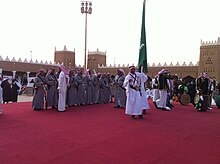Ardah
You can help expand this article with text translated from the corresponding article in Arabic. Click [show] for important translation instructions.
|
You can help expand this article with text translated from the corresponding article in Simple English. Click [show] for important translation instructions.
|

Ardah (Arabic: العرضة / ALA-LC: al-‘arḍah) is a type of folkloric group dance in the Arabian Peninsula, especially Saudi Arabia. It is also performed in other countries in the Gulf Cooperation Council. The dance is performed with two rows of men opposite of one another, each of whom may or may not be wielding a sword or cane, and is accompanied by drums and spoken poetry.[1]
Originally, the "ardah" was performed only by males of tribes of the Arabian Peninsula before going to war, but nowadays it is done at celebrations, weddings, and national and cultural events by males of all tribes, such as the Jenadriyah festival. There currently exists various types of ardah across the Arabian Peninsula.[1]
It was inscribed on UNESCO's Intangible Cultural Heritage of Humanity in 2015 as Alardah Alnajdiyah.[2]
Variations[edit]
| Alardah Alnajdiyah | |
|---|---|
 Ardah at Jenadriyah | |
| Country | Saudi Arabia |
| Domains | dance, drumming and poetry. |
| Reference | 01196 |
| Inscription history | |
| Inscription | 2015 |
| List | Representative |
 | |
The term 'ardah' (عَرْضَة) is thought to derive from the Arabic verb ard (عَرَضَ) meaning 'to show' or 'to parade'. It was so named because its purpose was to publicly display the fighting strength of a tribe and boost morale before an armed engagement.[1] Although there are regional variations of the particular rendition of ardah, the purpose it serves is nearly identical throughout the Arabian Peninsula.[1]
Saudi ardah[edit]
Najdi ardah is the most common variant of ardah in Saudi Arabia. It is also the most practiced and highly televised male folkloric dance in the entire country. The Saudi government changed its name to 'Saudi ardah' in the 21st century. However, there are numerous variations of ardah distinct from Najdi ardah throughout the country, notably in the regions of Najran, Asir and Jizan.[3]
See also[edit]
References[edit]
- ^ a b c d Urkevich, Lisa (19 December 2014). "5". Music and Traditions of the Arabian Peninsula: Saudi Arabia, Kuwait, Bahrain, and Qatar (Google Play). Routledge. p. 131/689. ISBN 978-0415888721.
- ^ "UNESCO - Alardah Alnajdiyah, dance, drumming and poetry in Saudi Arabia". ich.unesco.org. Retrieved 2019-02-07.
- ^ Urkevich, Lisa (19 December 2014). "5". Music and Traditions of the Arabian Peninsula: Saudi Arabia, Kuwait, Bahrain, and Qatar (Google Play). Routledge. p. 133/689. ISBN 978-0415888721.

